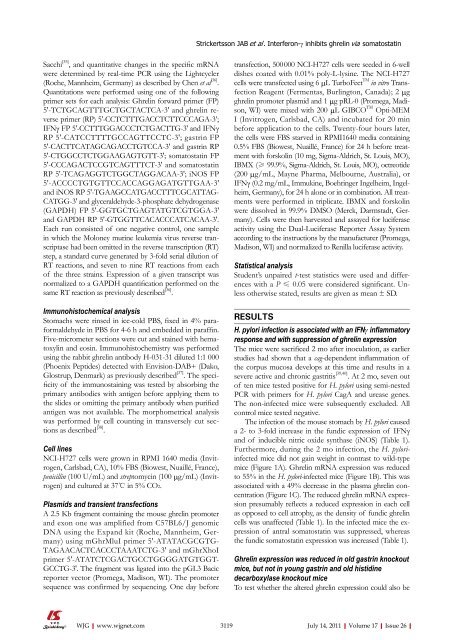26 - World Journal of Gastroenterology
26 - World Journal of Gastroenterology
26 - World Journal of Gastroenterology
You also want an ePaper? Increase the reach of your titles
YUMPU automatically turns print PDFs into web optimized ePapers that Google loves.
Sacchi [35] , and quantitative changes in the specific mRNA<br />
were determined by real-time PCR using the Lightcycler<br />
(Roche, Mannheim, Germany) as described by Chen et al [36] .<br />
Quantitations were performed using one <strong>of</strong> the following<br />
primer sets for each analysis: Ghrelin forward primer (FP)<br />
5'-TCTGCAGTTTGCTGCTACTCA-3' and ghrelin reverse<br />
primer (RP) 5'-CCTCTTTGACCTCTTCCCAGA-3’;<br />
IFNγ FP 5'-CCTTTGGACCCTCTGACTTG-3' and IFNγ<br />
RP 5'-CATCCTTTTGCCAGTTCCTC-3'; gastrin FP<br />
5'-CACTTCATAGCAGACCTGTCCA-3' and gastrin RP<br />
5'-CTGGCCTCTGGAAGAGTGTT-3'; somatostatin FP<br />
5'-CCCAGACTCCGTCAGTTTCT-3' and somatostatin<br />
RP 5'-TCAGAGGTCTGGCTAGGACAA-3'; iNOS FP<br />
5'-ACCCCTGTGTTCCACCAGGAGATGTTGAA-3'<br />
and iNOS RP 5'-TGAAGCCATGACCTTTCGCATTAG-<br />
CATGG-3' and glyceraldehyde-3-phosphate dehydrogenase<br />
(GAPDH) FP 5'-GGTGCTGAGTATGTCGTGGA-3'<br />
and GAPDH RP 5'-GTGGTTCACACCCATCACAA-3'.<br />
Each run consisted <strong>of</strong> one negative control, one sample<br />
in which the Moloney murine leukemia virus reverse transcriptase<br />
had been omitted in the reverse transcription (RT)<br />
step, a standard curve generated by 3-fold serial dilution <strong>of</strong><br />
RT reactions, and seven to nine RT reactions from each<br />
<strong>of</strong> the three strains. Expression <strong>of</strong> a given transcript was<br />
normalized to a GAPDH quantification performed on the<br />
same RT reaction as previously described [36] .<br />
Immunohistochemical analysis<br />
Stomachs were rinsed in ice-cold PBS, fixed in 4% paraformaldehyde<br />
in PBS for 4-6 h and embedded in paraffin.<br />
Five-micrometer sections were cut and stained with hematoxylin<br />
and eosin. Immunohistochemistry was performed<br />
using the rabbit ghrelin antibody H-031-31 diluted 1:1 000<br />
(Phoenix Peptides) detected with Envision-DAB+ (Dako,<br />
Glostrup, Denmark) as previously described [37] . The specificity<br />
<strong>of</strong> the immunostaining was tested by absorbing the<br />
primary antibodies with antigen before applying them to<br />
the slides or omitting the primary antibody when purified<br />
antigen was not available. The morphometrical analysis<br />
was performed by cell counting in transversely cut sections<br />
as described [38] .<br />
Cell lines<br />
NCI-H727 cells were grown in RPMI 1640 media (Invitrogen,<br />
Carlsbad, CA), 10% FBS (Biowest, Nuaillé, France),<br />
penicillin (100 U/mL) and streptomycin (100 µg/mL) (Invitrogen)<br />
and cultured at 37℃ in 5% CO2.<br />
Plasmids and transient transfections<br />
A 2.5 Kb fragment containing the mouse ghrelin promoter<br />
and exon one was amplified from C57BL6/J genomic<br />
DNA using the Expand kit (Roche, Mannheim, Germany)<br />
using mGhrMluI primer 5'-ATATACGCGTG-<br />
TAGAACACTCACCCTAAATCTG-3' and mGhrXhoI<br />
primer 5'-ATATCTCGACTGCCTGGGGATGTGGT-<br />
GCCTG-3'. The fragment was ligated into the pGL3 Bacic<br />
reporter vector (Promega, Madison, WI). The promoter<br />
sequence was confirmed by sequencing. One day before<br />
WJG|www.wjgnet.com<br />
Strickertsson JAB et al . Interferon-γ inhibits ghrelin via somatostatin<br />
transfection, 500 000 NCI-H727 cells were seeded in 6-well<br />
dishes coated with 0.01% poly-L-lysine. The NCI-H727<br />
cells were transfected using 6 µL TurboFect TM in vitro Transfection<br />
Reagent (Fermentas, Burlington, Canada); 2 µg<br />
ghrelin promoter plasmid and 1 µg pRL-0 (Promega, Madison,<br />
WI) were mixed with 200 µL GIBCO TM Opti-MEM<br />
I (Invitrogen, Carlsbad, CA) and incubated for 20 min<br />
before application to the cells. Twenty-four hours later,<br />
the cells were FBS starved in RPMI1640 media containing<br />
0.5% FBS (Biowest, Nuaillé, France) for 24 h before treatment<br />
with forskolin (10 mg, Sigma-Aldrich, St. Louis, MO),<br />
IBMX (≥ 99.9%, Sigma-Aldrich, St. Louis, MO), octreotide<br />
(200 µg/mL, Mayne Pharma, Melbourne, Australia), or<br />
IFNγ (0.2 mg/mL, Immukine, Boehringer Ingelheim, Ingelheim,<br />
Germany), for 24 h alone or in combination. All treatments<br />
were performed in triplicate. IBMX and forskolin<br />
were dissolved in 99.9% DMSO (Merck, Darmstadt, Germany).<br />
Cells were then harvested and assayed for luciferase<br />
activity using the Dual-Luciferase Reporter Assay System<br />
according to the instructions by the manufacturer (Promega,<br />
Madison, WI) and normalized to Renilla luciferase activity.<br />
Statistical analysis<br />
Student’s unpaired t-test statistics were used and differences<br />
with a P ≤ 0.05 were considered significant. Unless<br />
otherwise stated, results are given as mean ± SD.<br />
RESULTS<br />
H. pylori infection is associated with an IFNγ inflammatory<br />
response and with suppression <strong>of</strong> ghrelin expression<br />
The mice were sacrificed 2 mo after inoculation, as earlier<br />
studies had shown that a cag-dependent inflammation <strong>of</strong><br />
the corpus mucosa develops at this time and results in a<br />
severe active and chronic gastritis [39,40] . At 2 mo, seven out<br />
<strong>of</strong> ten mice tested positive for H. pylori using semi-nested<br />
PCR with primers for H. pylori CagA and urease genes.<br />
The non-infected mice were subsequently excluded. All<br />
control mice tested negative.<br />
The infection <strong>of</strong> the mouse stomach by H. pylori caused<br />
a 2- to 3-fold increase in the fundic expression <strong>of</strong> IFNγ<br />
and <strong>of</strong> inducible nitric oxide synthase (iNOS) (Table 1).<br />
Furthermore, during the 2 mo infection, the H. pyloriinfected<br />
mice did not gain weight in contrast to wild-type<br />
mice (Figure 1A). Ghrelin mRNA expression was reduced<br />
to 55% in the H. pylori-infected mice (Figure 1B). This was<br />
associated with a 49% decrease in the plasma ghrelin concentration<br />
(Figure 1C). The reduced ghrelin mRNA expression<br />
presumably reflects a reduced expression in each cell<br />
as opposed to cell atrophy, as the density <strong>of</strong> fundic ghrelin<br />
cells was unaffected (Table 1). In the infected mice the expression<br />
<strong>of</strong> antral somatostatin was suppressed, whereas<br />
the fundic somatostatin expression was increased (Table 1).<br />
Ghrelin expression was reduced in old gastrin knockout<br />
mice, but not in young gastrin and old histidine<br />
decarboxylase knockout mice<br />
To test whether the altered ghrelin expression could also be<br />
3119 July 14, 2011|Volume 17|Issue <strong>26</strong>|

















